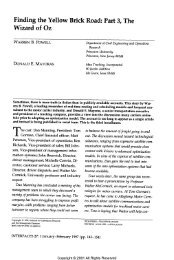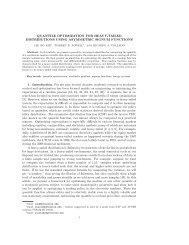lecture. - CASTLE Lab - Princeton University
lecture. - CASTLE Lab - Princeton University
lecture. - CASTLE Lab - Princeton University
Create successful ePaper yourself
Turn your PDF publications into a flip-book with our unique Google optimized e-Paper software.
Proof of Theorem 1<br />
Perturbation Theorems<br />
Consider ˜xf ∈ argmin Cf, and ˜xg ∈ argmin C,ɛg N. We have<br />
g(˜xg) ≤ minCg +ɛ ≤ g(¯xf)+ɛ, implying g(˜xg)−g(¯xf) ≤ ɛ. Therefore,<br />
f(˜xg)−f(¯xf) = g(˜xg)−η(˜xg)−[g(¯xf −η(¯xf)]<br />
= g(˜xg)−g(¯xf)+η(¯xf)−η(˜xg) ≤ ɛ+κ˜xg −¯xf,<br />
where the last inequality is obtained by using the Lipschitz condition on η. On<br />
the other hand, f(˜xg)−f(¯xf) ≥ c[dist(˜xg,Sf)] γ . For any δ > 0, we can choose<br />
¯xf such that ˜xg −¯xf ≤ dist(˜xg,Sf)+δ. Therefore<br />
f(˜xg)−f(¯xf) ≥ c[˜xg −¯xf−δ] γ .<br />
We have thus obtained c[˜xg −¯xf−δ] γ ≤ ɛ+κ˜xg −¯xf. By letting δ → 0<br />
yields ˜xg −¯xf → dist(˜xg,Sf) and the relation<br />
cy γ ≤ ɛ+κy<br />
where y = dist(˜xg,Sf) ≥ 0. The results for particular values of γ follow by<br />
solving for y. When γ = 2 one has to solve cy 2 −κy −ɛ ≤ 0,y ≥ 0. When<br />
γ = 1 one has to solve (c −κ)y ≤ ɛ,y ≥ 0.<br />
Boris Defourny (ORFE) Lecture 6: Perturbation Analysis in Optimization March 15,2012 23 / 26








